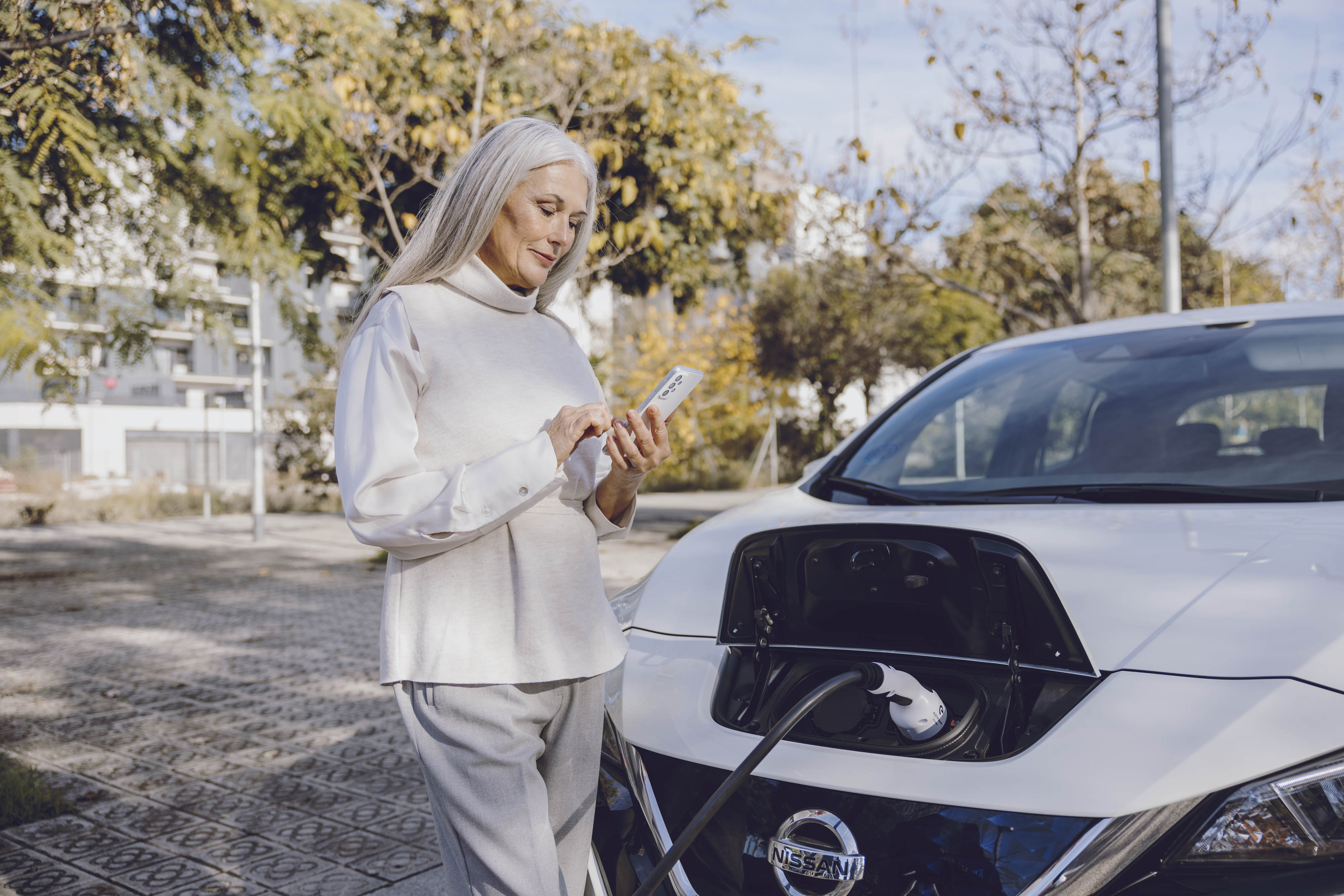As the world moves towards greener technologies and sustainable energy solutions, the intersection of electric vehicles (EVs) and solar energy has captured the imagination of many. Charging an electric vehicle with solar power seems like the perfect marriage of eco-friendly technologies. But is it truly a good option? This article explores how solar-powered charging systems work, their long-term costs and benefits, and real-world experiences to provide a comprehensive understanding. - And if you want to discover more innovations in the world of EV charging, read our last article -
How Solar-Powered Charging Systems Work
Solar-powered charging systems for electric vehicles harness energy from the sun using solar panels, convert it into electricity, and store it in a battery or send it directly to charge an EV. Here’s a step-by-step breakdown of how the process works:
1. Solar Panels Capture Sunlight
Solar panels, typically installed on rooftops, capture sunlight and convert it into direct current (DC) electricity through the photovoltaic effect. The efficiency of this process depends on factors like the quality of the solar panels, the angle of installation, geographic location, and weather conditions.
2. Inverter Converts DC to AC
The DC electricity generated by the solar panels is not directly compatible with most home appliances or the electrical grid, which operate on alternating current (AC). Therefore, an inverter is used to convert DC into AC electricity, making it usable for charging an EV or powering a home.
3. Power Distribution
Once converted, the AC electricity can be used in several ways:
- Direct Charging: The electricity can be used immediately to charge an EV if it’s connected and ready to charge.
- Home Usage: The electricity can be used to power household appliances, reducing overall electricity costs.
- Battery Storage: Excess energy can be stored in home batteries for later use, such as charging an EV at night when the sun is not shining.
- Grid Feed: In some cases, surplus energy can be fed back into the grid, potentially earning credits or payments from utility companies through net metering programs.
4. EV Charging
The charging of an EV from solar power happens through an EV charger, which connects to the vehicle and supplies the necessary power. The speed of charging can vary depending on the capacity of the solar array and the charger, with options ranging from slow Level 1 chargers to faster Level 2 or even Level 3 chargers for rapid charging. - If you want to know more about how sustainable energy can be integrated in EV charging, also read our article on the subject -

Long-Term Costs and Benefits

Investing in a solar-powered EV charging system can have significant long-term financial and environmental benefits, but it also involves upfront costs and considerations.
Initial Costs
The initial costs of setting up a solar-powered charging system include:
- Solar Panels: The cost of solar panels can range from $10,000 to $30,000, depending on the size of the installation and the quality of the panels.
- Inverter: A good quality inverter can cost between $1,000 and $3,000.
- Battery Storage (Optional): A home battery system like the Tesla Powerwall can cost between $7,000 and $15,000.
- Installation Costs: Professional installation fees, which vary based on the complexity of the installation and local labor rates.
These costs can be offset by government incentives, tax credits, and rebates available in many regions for solar installations and EV charging stations.
Maintenance and Longevity
Solar panels are generally low maintenance, with most systems requiring minimal upkeep and having a lifespan of 25-30 years. Inverters typically last 10-15 years before needing replacement. Battery systems, while offering added convenience, may require more frequent maintenance or replacement depending on usage.
Savings on Energy Costs
One of the most significant benefits of using solar energy to charge an EV is the reduction in electricity costs. By generating your own electricity, you can significantly reduce or even eliminate the cost of charging your EV, depending on your driving habits and the size of your solar system.
- Energy Independence: Solar power allows EV owners to become more energy-independent, lessening reliance on fluctuating grid electricity prices.
- Return on Investment: Over time, the savings on electricity and potential earnings from selling excess power back to the grid can result in a return on the initial investment, often within 5 to 10 years.
Environmental Impact
Charging an EV with solar power significantly reduces the vehicle's carbon footprint, as the electricity is sourced from a renewable and clean energy source. This contrasts with charging from the grid, where the electricity may still come from fossil fuels in many regions.
- Reduction in Greenhouse Gas Emissions: Solar-powered EV charging drastically cuts down on greenhouse gas emissions, contributing to global efforts to combat climate change.
- Sustainable Lifestyle: Embracing solar power for EV charging is part of a broader commitment to sustainability and reducing one's overall environmental impact.
Case Studies and User Experiences

The real-world application of solar-powered EV charging has seen a variety of outcomes, with many users reporting positive experiences. Let’s explore a few case studies that highlight the benefits and challenges of this technology.
Case Study 1: The Thomas Family in California
The Thomas family, living in sunny California, installed a 6 kW solar panel system in 2018, along with a Tesla Powerwall to store excess energy. They also purchased a Tesla Model 3 and decided to charge it primarily using their solar power system.
- Initial Investment: The total cost of their solar installation and Powerwall was approximately $25,000, reduced to $17,500 after federal and state incentives.
- Energy Savings: Over the next three years, the Thomas family reported saving over $3,000 annually on electricity bills, including the cost of charging their EV. They estimate that they will break even on their investment within 6 to 7 years.
- User Experience: The family appreciates the convenience of charging their EV at home and values their reduced environmental footprint. However, they noted that on overcast days, they occasionally had to rely on grid electricity.
Case Study 2: Solar-Powered EV Charging Station in Australia
A public EV charging station powered by solar energy was installed in Australia as part of a government initiative to promote sustainable transportation. The station features a large array of solar panels and offers free charging to EV owners.
- Public Benefits: The station has encouraged more people to adopt EVs, knowing they can charge sustainably. It also serves as an educational tool, demonstrating the viability of solar power in public infrastructure.
- Challenges: The station faced initial challenges in maintaining a consistent power supply during prolonged periods of poor weather, leading to temporary reliance on the grid. However, with the addition of a battery storage system, these issues were largely mitigated.
Case Study 3: Individual User Experience in Germany
Johann, an EV owner in Germany, installed a modest 3.5 kW solar panel system on his garage roof to charge his Nissan Leaf. Living in a region with less consistent sunlight than southern Europe, Johann wanted to explore the feasibility of solar charging in less sunny climates.
- Installation Cost: Johann's system cost approximately €10,000, with a small government rebate reducing the net cost to €8,500.
- Energy Production: Despite the less ideal sunlight conditions, Johann’s system generates enough power during the summer months to cover 70% of his EV’s charging needs, dropping to around 40% during the winter.
- Overall Satisfaction: Johann is satisfied with his setup, enjoying reduced electricity bills and a smaller carbon footprint. He acknowledges that the return on investment will take longer compared to sunnier regions but still believes in the long-term benefits.
Conclusion: Is Solar-Powered Charging a Good Option?
Charging an electric vehicle with solar energy is indeed a good option for many, offering both financial and environmental benefits. However, its suitability depends on several factors, including geographic location, the availability of incentives, and individual energy consumption patterns.
For those living in sunny regions with high electricity costs, the financial savings and environmental impact of solar-powered EV charging can be substantial. Even in less sunny areas, the technology can still offer significant benefits, especially when combined with battery storage solutions to mitigate variability in sunlight.
The initial costs of installation can be a barrier for some, but with the availability of incentives and the potential for long-term savings, many users find the investment worthwhile. Moreover, the combination of solar power and electric vehicles aligns with a broader commitment to sustainability, reducing dependence on fossil fuels and contributing to the fight against climate change.
As technology continues to advance, making solar panels and battery storage more efficient and affordable, solar-powered EV charging is likely to become an increasingly attractive option for a wider audience. Whether for individual homeowners, public charging stations, or businesses, this green technology holds great promise for a sustainable future.









.png)
%20(1).png)




.png)


